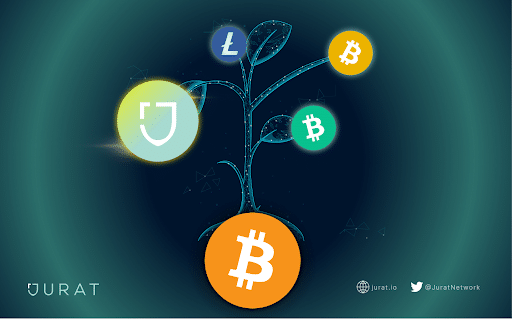Trump’s proposed US takeover of Gaza Strip elicits positive response across administration
Is JTC More Than Just Another Bitcoin Fork?


$JTC is part of the family of Bitcoin forks, but its legal recourse features make it stand out from the crowd.
Is JTC More Than Just A Bitcoin Fork?
Successive branches of Bitcoin have emerged that all claim to improve Satohsi’s original vision in one way or another. Generally, these branches, namely Bitcoin SV and Bitcoin Cash, offer the same features as BTC but with larger block sizes and faster transaction speeds. They do not innovate beyond what the cryptocurrency space already offers on other blockchains. As a result, their values pale in comparison to BTC.
To actually achieve Satoshi’s vision of a mainstream money for the internet age, something entirely new is needed – the ability to protect one’s savings and reclaim value, meaning enforceable property rights. That is where JTC comes in.
The JTC blockchain is a unique branch of Bitcoin that provides a layer for legal enforcement in every transaction. In keeping with Satoshi’s plan for a fairer financial system where central banks cannot debase the value of someone’s savings, JTC maintains the Bitcoin core but adds mainstream legal protections for the individual user. Cryptocurrency users can finally enforce their property rights on-chain and obtain legal recourse from malicious actors like fraudsters and hackers while also recovering from mistakes like lost private keys.
Jurat’s objective is to use the JTC branch to create a blockchain space that doesn’t demand users take on unfeasible levels of risk. The lack of on-chain legal recourse has so far hindered mainstream adoption, but the JTC branch has shown that Satoshi’s vision doesn’t demand a crypto wild west – it can be integrated with legal remedies that benefit everyone who interacts with a blockchain.
A Brief History of Bitcoin Branches
The evolution of Bitcoin has been marked by a series of forks or divergences from the original blockchain. These forks have arisen from various factors, including disagreements over protocol changes, community debates, and the introduction of new features.
Many blockchains have forked the Bitcoin software to create a new payment ledger such as Litecoin (of LTC). However, the first major fork within the Bitcoin community occurred in 2017 when a group of developers proposed a scaling solution known as SegWit (Segregated Witness). However, a significant portion of the community opposed SegWit, leading to a hard fork that resulted in the creation of Bitcoin Cash (BCH).
BCH retained the original Bitcoin protocol but introduced a larger block size to accommodate more transactions. Eventually, there was dissent within the BCH community, leading to the founding of BSV, a project plagued by dubious claims by its founder to the title of Satoshi.
JTC, a judiciary-connected branch of Bitcoin, is the latest development in Bitcoin’s short yet fascinating journey.
The Story Behind Jurat
Jurat, much like past Bitcoin forks, is the result of a passion and vision for completing Satoshi’s work to bring Bitcoin mainstream. Jurat’s place in the history of Bitcoin begins with Mike Kanovitz, the CEO and Jurat co-founder. As a Founding Partner of the law firm Loevy & Loevy and a long-time Bitcoin enthusiast, he saw that the lack of legal recourse to victims of frauds and crimes was discouraging would-be adopters and keeping Bitcoin on the fringes of the financial system.
“The genius of Bitcoin can offer financial freedom to users worldwide. However, it is cut off from the legal system that users need to enforce their property rights and obtain law enforcement protection from criminal organizations,” Kanovitz told Crypto News. “Most people will not adopt cryptocurrency as an everyday form of money if they must give up legal protections for their life savings.”
No public blockchain has solved the problem of how to remain decentralized while enforcing the law. The result has been a frenzy of scams and hacks that have stolen billions of dollars in digital assets from individuals and organizations.
Very few people who have fallen victim to a scam or lost their private keys have been able to recover their assets. As a result, most institutions and individuals consider blockchains too risky, even if they offer massive advantages over traditional financial systems. This risk has deterred widespread adoption, reduced the value of the digital asset market, emboldened criminals, and given regulators a mountain of excuses to clamp down on the industry.
“Jurat’s vision is based on the idea that Bitcoin is a superior form of money that can achieve mainstream adoption if the current lack of legal recourse is overcome,” said Kanovitz.
The JTC blockchain and the $JTC token adhere to Bitcoin’s philosophy while adding a legal recourse layer that makes blockchain tech safer and fairer.
$JTC BitMart Listing Confirmed
$JTC was created at a 1:1 ratio with $BTC at the time of the JTC fork on January 8, 2022, at Block Height 717808. Bitcoin holders from before the fork date can claim their $JTC for free, while others are waiting for the first listing.
The wait is finally over, as BitMart announced on December 8 that $JTC would be listed on the exchange. Users wishing to obtain $JTC and join the first blockchain that brings legal recourse directly to the user will be able to do so by visiting BitMart’s $JTC spot trading page, once the listing goes live over the coming week or so.
JTC Branch Sparks an On-Chain Legal Revolution
The Jurat Bitcoin branch, JTC, holds true to Bitcoin’s core philosophy of improving the financial autonomy of individuals by eliminating the threat of inflation, assuring self-custody, and eliminating third-party intermediaries. In addition, JTC offers users crypto recovery tools that discourage hackers and scammers from stealing assets in the first place.
JTC is built on the Bitcoin Core code and adds protocols for the blockchain to communicate directly with state and federal courts. This is made possible by Jurat, a system for making court orders machine-readable and connecting court dockets with blockchain nodes. As a result, miners using Jurat can implement court orders without any intermediaries, not even attorneys. Miners remain decentralized, operating under a proof-of-work (PoW) consensus mechanism and earning coins for creating blocks.
If someone falls victim to a scam, they can bring it to court just as they would in the case of any other type of theft. If the court rules in their favor, the judge will specify a transaction to return the coins to the victim, and the miners will automatically implement it on-chain. Additional features include freezing a disputed coin so that the parties have an opportunity to adjudicate their legal rights.
JTC’s protocols mean blockchain users no longer need to suffer in legal limbo. This reduces the level of risk that comes with owning digital assets and opens the door to mainstream adoption. Furthermore, it reduces the threat of suffocating regulations as the capability for decentralized operators to assure legal compliance reduces the perceived need for regulators to pursue harsh rules and legislation.
Final Thoughts on JTC as Just Another Bitcoin Fork
Bitcoin forks are a natural part of the evolution of Bitcoin and a way for the community to build on Satoshi’s vision. Most Bitcoin forks have focused on transaction speeds and block sizes, doing nothing to advance the mainstreaming of Bitcoin. JTC is different. This Bitcoin branch has tasked itself with bridging the protection of the law to blockchain technology.
JTC users benefit from legal remedies in the event of scams and mistakes while upholding the core monetary ideology behind Bitcoin. The legal solutions offered by Jurat can make cryptocurrency safer, fairer, and more appealing to institutions and individuals.
Disclaimer: The text above is an advertorial article that is not part of Cryptonews.com editorial content.
The post Is JTC More Than Just Another Bitcoin Fork? appeared first on Cryptonews.











